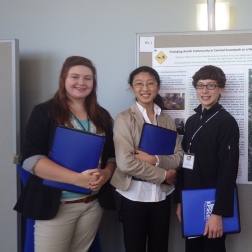Three Presque Isle High School students have gained excellent field work and research experience—and received recognition during a statewide conference—thanks to the Experimental Program to Stimulate Competitive Research [EPSCoR] grant project underway at the University of Maine at Presque Isle.
Over the last year, junior Angela Wang and sophomores Sedona Lucas and Zach Rice have assisted with research connected to UMPI’s EPSCoR project, which is focused on assessing the feasibility and sustainability of grass biomass production for central Aroostook County.
Working closely with Dr. Chunzeng Wang, one of the members of the grant research team and UMPI Associate Professor of Earth and Environmental Science, the students have conducted a wide range of work and activities, including land-use GIS mapping work, ground truthing, Amish land-use surveys, and interviews with town officials and Amish leaders.
“The students started working with us on the EPSCoR project as part of UMPI’s Central Aroostook Math and Science Partnership (CAMSP) project in fall 2012,” Dr. Wang said. “EPSCoR itself loves to have high school students get involved in its research projects. Our EPSCoR has a small budget to compensate their work. However, that is not the point. The point is they gain valuable research experience by working on a real, National Science Foundation-funded research project and by working as a team with university professors. They have learned not only the GIS technology and identification of various grassland classes and land uses, but also problem-solving skills and team spirit. In addition, they have learned how to present their work to a public audience, which provides them with excellent academic experiences while still in high school.”
As part of their EPSCoR research, the students have spent time since fall 2012 examining landscape and land use changes in central Aroostook, in particular in the towns of Easton and Fort Fairfield, due to the emerging Amish community. Through surveys, interviews and mapping efforts, they learned that Amish families are attracted to central Aroostook because of its many acres of low-cost land, in particular fallow land that used to be potato fields. Based on GIS mapping, they determined that the Amish own more than 2,000 acres of land in Easton and Fort Fairfield, and also lease hundreds of acres for pasture and hay from their neighboring landowners. Because they turn fallow land and densely-wooded fallow land into pasture, hayfield, and croplands, they are playing a critical and positive role in landscape and land-use change in the County.
“It has been really interesting connecting the work we do on the computer to what we are seeing out in the County,” Sedona Lucas said about UMPI’s EPSCoR project. “I’ve learned a lot about the Amish. It was scary at first to be doing the same work as college students, but we were able to get everything done.”
With Dr. Wang’s help, the students have been able to present their research in two different forums. In August, they joined college students and UMPI faculty members in delivering PowerPoint presentations to the campus and community about the EPSCoR research that has been underway at UMPI over the last year. All three students were able to deliver a portion of their presentation, share aspects of their research, and answer questions.
In addition, the high schoolers had the opportunity to attend the Maine EPSCoR State Conference on Sept. 30 at the University of Maine in Orono, where they heard presentations about EPSCoR research underway throughout the state. During this conference, they participated in the poster presentation, showcasing their poster “Emerging Amish Community in Central Aroostook as a New Factor in Landscape/Land-Use Change.” They won the best poster prize for the high school category and received an iPad Mini, which will be used for future research efforts.
“The cooperation between the University of Maine at Presque Isle and Presque Isle High School continues to grow with this exciting EPSCoR project,” Presque Isle High School Principal Donna Lisnik said. “Through this opportunity our students have grown in their research skills, oral and written presentation, and team work. I am both excited for these three students and proud of their work. Their winning poster is predominately displayed as one walks into the front lobby of PIHS as an example of their excellent work as well as the cooperation between UMPI and PIHS.”
Though their spring and summer research efforts are complete, the three students will be exploring new topics related to UMPI’s overall EPSCoR project during the 2013-2014 academic year. They are now working on a land-use GIS mapping project for part of the City of Caribou; and they will be part of a team focused on creating and implementing a 12-lesson unit for K-12 teachers about historical and future land use patterns and grass biomass production in central Aroostook.
“Zach, Sedona, and Angela have been valuable contributors to our overall project, and it was enjoyable to see them present so well at the state conference among undergraduates, graduate students, and university faculty presenters,” Dr. Jason Johnston, UMPI’s EPSCoR project team leader and UMPI Associate Professor of Wildlife Ecology, said. “It’s interesting to see what they have learned and summarized about Amish land use in Easton and Fort Fairfield, and it’s amazing to see what students can accomplish when they are engaged in this kind of hands-on project.”
For more information about UMPI’s EPSCoR project, please visit www.umpi.edu/academics/environmental-studies/epscor.
Note: In late October, the high school students received another honor for their poster, which was displayed during the 6th Annual GIS Educators in Maine & MEGUG (Maine GIS Users Group) Fall Conference–the prize for best poster in the high school category. The award included 10 books for the students and 10 books for the faculty supervisor.
